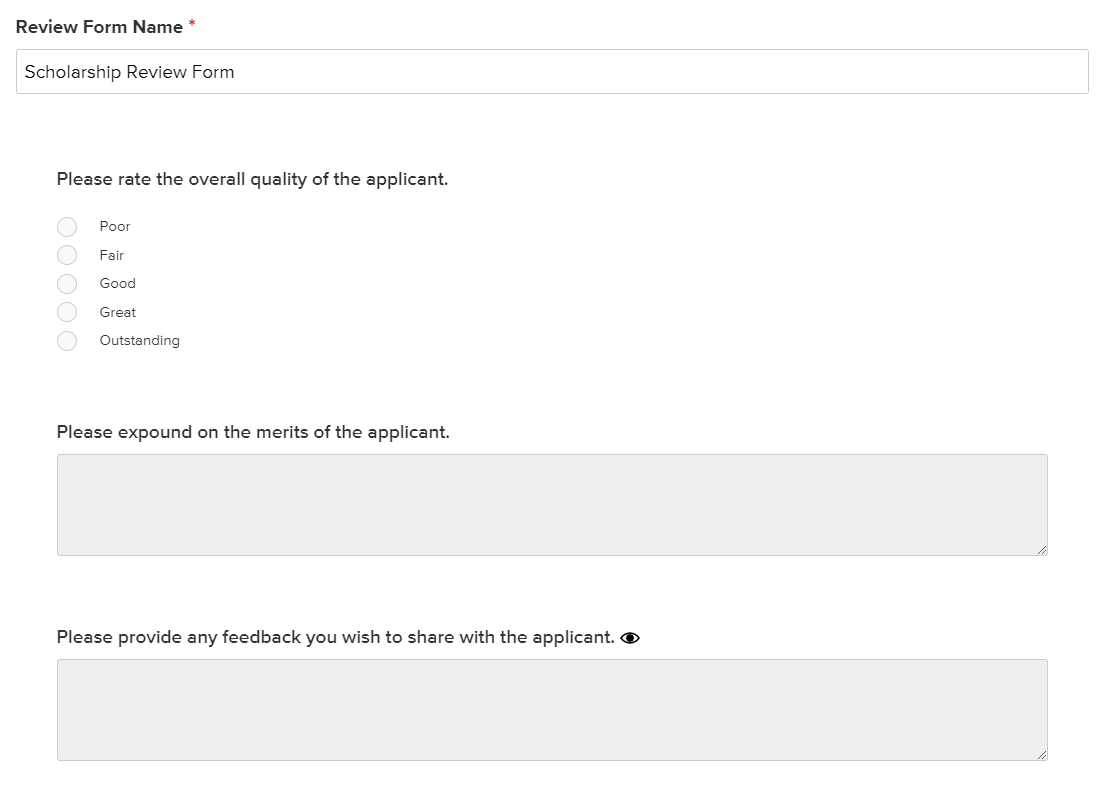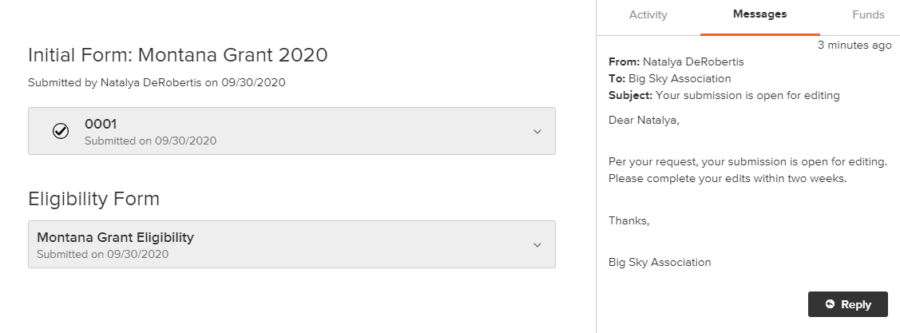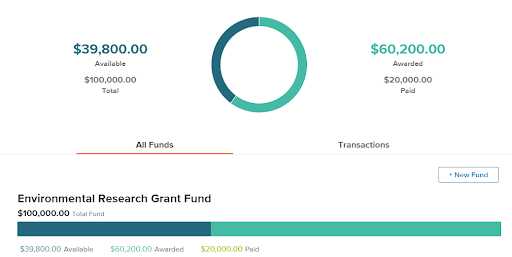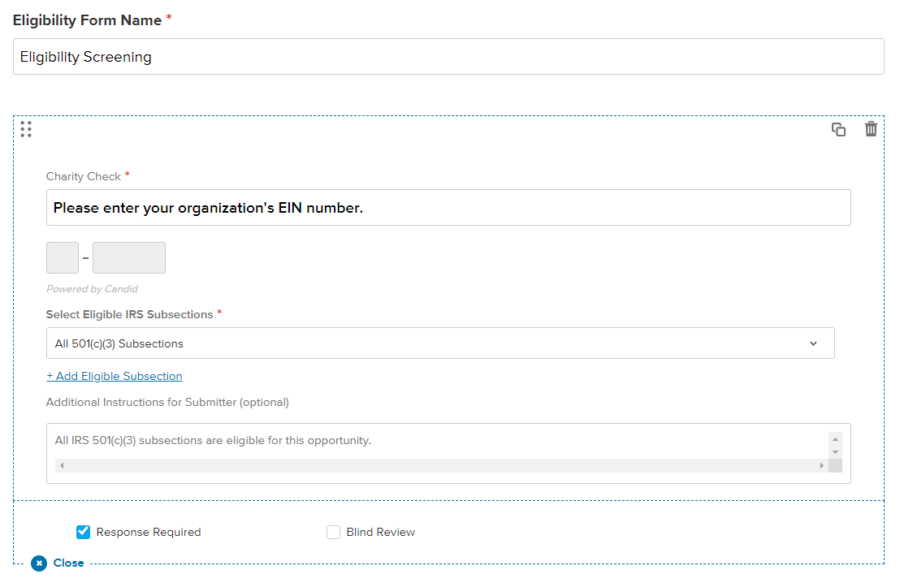SlideRoom and Submittable are both application management and tracking platforms that can facilitate a wide variety of processes. From residencies and fellowships, to awards and contests, to grants and scholarships, to HR and hiring, customers love both solutions for their ease of use and customization.
However, there are key differences between the two platforms:
Features at a Glance
| Submittable | SlideRoom | |
| Application collection | ||
| Eligibility screening | ✔ | X |
| Charity validation | ✔ | X |
| Real-time applicant collaboration | ✔ | X |
| Send additional forms | ✔ | X |
| Drag and drop form builder | ✔ | ✔ |
| Collect fees and payments | ✔ | ✔ |
| File uploads | ✔ | ✔ |
| Responsive forms with branching | ✔ | ✔ |
| Branded landing page | ✔ | ✔ |
| Gather third party references | ✔ | ✔ |
| Review and workflow | ||
| Email templates | ✔ | X |
| In-app communication | ✔ | X |
| Custom qualitative review | ✔ | X |
| Custom quantitative review | ✔ | ✔ |
| Side by side reviews | ✔ | ✔ |
| Blind reviews | ✔ | ✔ |
| Multiple rounds of review | ✔ | ✔ |
| Email in-progress applicants | ✔ | ✔ |
| Bulk actions | ✔ | ✔ |
| Search and filters | ✔ | ✔ |
| Tags/Labels | ✔ | ✔ |
| Reporting and more | ||
| Funds awarding and tracking | ✔ | X |
| In-app data analysis | ✔ | X |
| Permission levels | ✔ | ✔ |
| Data exports | ✔ | ✔ |
| API access | ✔ | ✔ |
| Integrations | ✔ | ✔ |
The Top Reasons to Choose Submittable
Here are nine reasons why Submittable is the better choice for many customers.
1. Submittable saves more time with eligibility screening
The ability to screen applicants for eligibility is a huge time-saver for both reviewers and applicants. Submittable offers eligibility forms and quizzes, which an applicant must fill out before continuing to the main application.
It’s respectful of applicant time, because anyone ineligible will be diverted before they make the effort to fill out the whole form. You can even customize the message these applicants will see.
On the review side, your team won’t waste any time reviewing applications that are a bad fit or don’t meet your criteria. It’s a win-win.
Using SlideRoom, administrators can add multiple forms to a program—but there is no similar way to divert ineligible applicants.
2. Submittable can gather impact reports or further information throughout a program’s lifecycle
One of Submittable’s most popular features is Additional Forms.
Customers send Additional Forms to applicants throughout the application process to:
- Keep applications concise. Use Additional Forms to gather further information from candidates when needed, such as for a final round of review.
- Gather impact reports. Customize Additional Forms to collect quarterly progress reports or year end reports, and send them to awardees when needed.
- Collect additional information. Should you determine that further information is needed from all or some applicants, Additional Forms are the tool for the job.
We used to collect everything up front. It was like, in case you are chosen as a semifinalist, please fill out this part of the form, and if you are chosen as a finalist, we’ll need this other thing so please also fill out this other section on the form. With [Submittable’s] Additional Forms, the initial application can be shorter and we can collect that information as needed.
Dylan Pickus, Manager of Artistic Programs, SPACE on Ryder Farm
While SlideRoom provides the ability to email applicants and include multiple forms at the outset, it does not offer a similar ability to send additional forms to applicants throughout a program.
Level up your submission or application process
Contact our team to see what you could accomplish with Submittable.
3. Submittable offers customizable qualitative reviews
Submittable and SlideRoom both allow administrators to build out scoring rubrics for reviewers. Quantitative reviews on each platform can be calculated cumulatively and by average score.
However, only Submittable’s review forms allow for the customization of reviewer feedback beyond a numerical scale and optional comments.
Submittable review forms can prompt reviewers to provide precisely the kind of feedback that is desired, including, but not limited to:
- Short or long answers
- File uploads
- Multiple choice, dropdown lists, and checkboxes
All options can be marked as required for reviewers, and can incorporate branch logic—keeping review forms concise and relevant. Submittable even gives you the option to share reviews anonymously with applicants.

In SlideRoom, reviewers may leave optional comments, but review forms cannot be configured to request specific qualitative feedback.
4. Submittable provides customizable, time-saving email templates
Submittable and SlideRoom both allow reviewers to trigger emails from within the platform, individually or in bulk. Both solutions also support personalization of certain variables in batch emails.
However, only Submittable provides time-saving, customizable email templates, including ones for submission response, acceptance, and declining. Administrators can also create as many other templates as needed.
Common template types may include:

- Letting an applicant know their submission is open to editing,
- Sending an applicant an Additional Form and including instructions,
- Updating an applicant as to the status of their application,
- Scheduling interviews, and
- Requesting further information.
When emailing applicants individually or in bulk, your reviewers can simply select a template and make any necessary edits before sending. It saves a ton of time—everyone appreciates not having to reinvent the wheel each time a routine action is performed.
In SlideRoom, all emails must be written from scratch.
5. Submittable has in-app communication
When using SlideRoom, a reviewer can send an email, and determine which address the email will come from. However, the email itself is not viewable afterward in SlideRoom. Any responses to that email will be sent to that email address, and are not available within SlideRoom.
This means that conversations with applicants via SlideRoom happen within an individual reviewer’s email inbox, posing a few challenges:
- First, inboxes are notorious for overflowing and important information can be lost or overlooked.
- Second, the email chain loses the context of the application. Reviewers will be stuck toggling back and forth between tabs on their computers in order to see both the application and the correspondence.
- Finally, other reviewers will not have access to the conversation, which means important information could be lost, or that multiple reviewers will seek the same information—an inefficient process, and a headache for the applicant.
In Submittable, on the other hand, you can see all correspondence with applicants right within the platform; all messages are viewable alongside applications. There’s no need to dig through your inbox or toggle between tabs, and all reviewers have access to the correspondence.

We love the available template form letters, love the ease in communicating with reviewers— keeping everything related to one submission in that submission file, versus having to create email folders and to remember to file those emails.
Christi Craig, Publisher, Hidden Timber Books
6. Submittable can track the awarding and payment of funds
For application processes that ultimately lead to a monetary award—such as grants, scholarships, or accelerators—the ability to award and track funds within the application platform is a game-changer.
In Submittable, users can create multiple funds, and award and pay applicants in installments. Submittable’s funds dashboard also keeps everyone aware of their current capacity to give.

SlideRoom does not have a comparable awards tracking feature. For organizations that do not anticipate ever awarding funds to applicants, this differentiator is not necessarily a drawback. But Submittable customers who do make awards love the ability to track and visualize distributions.
We like [Submittable’s] more visual perspective of all the different funds and how much is awarded and paid out. When you have multiple programs and multiple funds, it’s so helpful to see where we’re at and track that information.
Angie Nelson, State of Montana
7. Submittable allows for real-time applicant collaboration
In Submittable, completing application forms can be collaborative.
Applicants can invite others to collaborate with them, and will see real-time field presence of their collaborators. With collaborator messaging, it’s easy to keep all team members in the loop.
Collaborative Submissions are great for students and teachers working on scholarship applications, teams applying to an incubator program, and many other kinds of collective opportunities.
SlideRoom doesn’t offer a similar applicant collaboration tool. Of course, not all opportunities are collective, so this feature may not matter to some organizations.
8. Submittable has better reporting tools
Reporting and data analysis are critical pieces of just about any program. In SlideRoom and Submittable, users can export data for further analysis.
However, only Submittable also supports in-app data analysis, including charts and graphs.
When looking for quick answers to stakeholder questions, this ease and convenience of in-app reporting can make a big difference vs. needing to export data into another program, as is required in SlideRoom.

9. Submittable can automatically pull data on nonprofits.
For organizations collecting applications from nonprofits, such as a grant or CSR program, Submittable offers the Charity Check feature.
This integration with Candid (formerly Guidestar) pulls verified nonprofit data based on the applicant’s IRS EIN number. It’s hugely time-saving for applicants and your team. Plus, you can also use Charity Check to screen applicants based on nonprofit statuses at the eligibility stage.
SlideRoom does not integrate with Candid or offer a similar feature.

Learn more about Submittable
This article highlighted many of the key differentiators between Submittable and SlideRoom. If you’re interested in learning more, watch our demo to see if Submittable may be a good fit for your program.